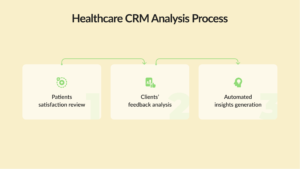How to Integrate a CRM Into Your Healthcare Establishment Flows
The user experience is the secret of business success and prosperity. That’s why companies prioritize striving to draw in a broader audience and render seamless services. Customer Relationship Management (CRM) systems are reliable helpers to take business interaction with clients to a new level.
This post will enlighten the CRM creation for management flows in a healthcare organization. You will find out more details about the essence of this software, its creation, and others.
What is a Healthcare CRM System?
Before talking about CRM implementation, let’s dive deeper into its essence. Customer Relationship Management (CRM) software for medical purposes is a digital product designed to assist healthcare managers in their job. It can be attracting, retaining, and further interacting with patients, as well as developing a specialized treatment for them. It also deals with pharm organizations and monetary flows, supporting the medical establishment activity on the whole.
Healthcare CRM use grows in popularity. So that, it satisfies different needs of medical establishments. Due to that, the stats forecast the increase of a medical CRM market value: according to Grand View Research data, the price of this market in the US is projected to grow to $17.8 billion with a Compound Annual Growth Rate (CAGR) of 9.1%.

Such success is a consequence of a bunch of benefits the CRM brings to managers of medical establishments. We’ll mention the most common of them below:
- Accurate reporting
- Personalized communication between the patient and healthcare service provider
- More effective marketing campaigns
- Opportunity to analyze patient behavior
- Improving the quality of rendering services, etc.
The said benefits are accomplished due to the below-described operating mechanism.

We’ve found out the fundamentals you should know about a healthcare CRM and its functioning. Now, it’s time to talk about its development and integration.
Also Read 11 Life-Threatening Diseases Poor Oral Healthcare Invites
How to Create and Integrate CRM for Medical Purposes?
What are the steps you should take to start medical software development and integrate the built product into your business flows? We’ll discuss it below, don’t hesitate to discover!
Contact IT specialists and start your cooperation. First, you’ll need the help of qualified specialists who understand all the ins and outs of healthcare CRM development. You can do that by choosing between two options for hiring: gathering an in-house team (you can apply to this option in case your budget allows you to do that) and collaborating with an outsourcing software development.
The last one is quite a perfect choice. This is because outsourcing experts can create, deliver and integrate a full-fledged medical CRM into your workflows more cost-effectively than it can be done in the previous case.
Moreover, if you choose collaboration with an outsourcing company, they’ll carefully help you pass through the development process. This way, they’ll assist you in finding all the solutions to various issues. For example, the experts will help you consider what type of software (CRM module integration, off-the-shelf solution, or custom software development) will be the best in your particular case, list of features to implement, and so on.
Decide on your future CRM design. The vendor’s UI/UX designers will create a clear interface for your future CRM platform. You can participate in this process, offering them your own design sketches. If you don’t have some, the designers will create every detail themselves. This way, you’ll be able to make your corrections or approve the part of the work done.
Control the development process. The developers’ task will be to bring the defined list of features to life. They can first code the core CRM features (e.g., scheduling and booking appointments and consultations, reporting, call operation, etc.). Then, they’ll work on advanced functionality creation and adding, in case you need it. All the parts of functionality are carefully checked by QA engineers for bugs. You may control the process and approve the created features if you’re satisfied with them.
Wait for the system’s release. The team will release your healthcare CRM and integrate it into your existing business flows. They will also teach your employees how to operate with the created system. After that, you can start using your healthcare CRM. Remember that the vendor’s IT experts that created this platform for you stay available for bug-fixing and updating your CRM. They can also give you tech consultations you need.
Also Read Oral Hygiene Instructions and Oral Cancer Screening Detailed
Bottom Line
Developing software for the healthcare business domain needs the experience of the specialists dealing with it. That’s why you can apply to a skilled medical software development vendor. The provider’s experts will be able to create a top-class Customer Relationship Management solution for your software establishment. It will attract more patients, help you give them on-time treatment and effectively manage your workflows.




